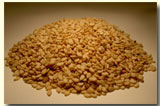|
|
DISTRIBUTION AND PRODUCTION
Sesame is essentially a crop of the tropical and sub-topical regions rather sensitive to low temperatures. It is grown in around 53 countries of the world in regions from 40-degrees north to 40-degrees south latitude. Asia contributes 68% in area and 61% in production of the world.
 The major sesame growing countries: The major sesame growing countries:
- ASIA:
India, China, Burma, Afghanistan
- AFRICA:
Sudan, Nigeria, Ethiopia, Somaliland
- AMERICA:
Mexico, Guatemala, Colombia, Venezuela
- EUROPE:
Greece
 The total production of sesame seeds has grown by 57% since 1980 or 2.4% per year. This growth is mainly accounted for by Asia where China tripled its production from 225,000 MT to 725,000 MT in 2000. The FAO statistics show that the exports more than doubled to 525,000 MT in 2000, representing an increase of almost 5% per year. In fact the growth has been significant and reflects the increasing demand for sesame seed in non-producing countries. The world import figures show an annual increase of more than 5% and the largest importers of sesame seed in the world are Japan and Korea who are responsiblefor 54% of all Asian imports and over one third of all world imports in 1998. Europe and 15 members of the European community saw their level of import more than triple in this period.Taking these aspects together, the general expectation lies at an annual growth of between 2 and 4%, which would be similar to the growth realized over the last 20 years. As long as researches are unveiling the health benefits of the 3000 year old seed, it is expected that demand for sesame and its derivatives of oil will constantly increase. The total production of sesame seeds has grown by 57% since 1980 or 2.4% per year. This growth is mainly accounted for by Asia where China tripled its production from 225,000 MT to 725,000 MT in 2000. The FAO statistics show that the exports more than doubled to 525,000 MT in 2000, representing an increase of almost 5% per year. In fact the growth has been significant and reflects the increasing demand for sesame seed in non-producing countries. The world import figures show an annual increase of more than 5% and the largest importers of sesame seed in the world are Japan and Korea who are responsiblefor 54% of all Asian imports and over one third of all world imports in 1998. Europe and 15 members of the European community saw their level of import more than triple in this period.Taking these aspects together, the general expectation lies at an annual growth of between 2 and 4%, which would be similar to the growth realized over the last 20 years. As long as researches are unveiling the health benefits of the 3000 year old seed, it is expected that demand for sesame and its derivatives of oil will constantly increase.
|

